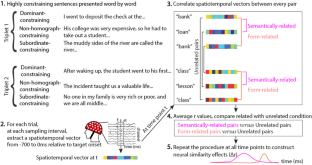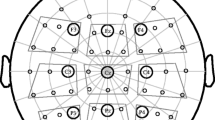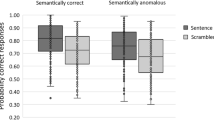Abstract
During language comprehension, the processing of each incoming word is facilitated in proportion to its predictability. Here, we asked whether anticipated upcoming linguistic information is actually pre-activated before new bottom-up input becomes available, and if so, whether this pre-activation is limited to the level of semantic features, or whether extends to representations of individual word-forms (orthography/phonology). We carried out Representational Similarity Analysis on EEG data while participants read highly constraining sentences. Prior to the onset of the expected target words, sentence pairs predicting semantically related words (financial “bank” – “loan”) and form-related words (financial “bank” – river “bank”) produced more similar neural patterns than pairs predicting unrelated words (“bank” – “lesson”). This provides direct neural evidence for item-specific semantic and form predictive pre-activation. Moreover, the semantic pre-activation effect preceded the form pre-activation effect, suggesting that top-down pre-activation is propagated from higher to lower levels of the linguistic hierarchy over time.



Similar content being viewed by others
Notes
In line with all accounts of predictive language comprehension, and all theories of post-onset homograph processing, we assume that in highly constraining contexts, the appropriate meaning of the homograph is pre-activated. For example, the dominant financial-related meaning of the word “bank” should be pre-activated following a dominant-constraining context, while the subordinate river-related meaning of the word “bank” should be pre-activated following the subordinate-constraining context. In the psycholinguistic literature, there has been some debate about whether, after a homograph is encountered from bottom-up input, we additionally access its contextually-inappropriate meaning. Addressing this question is outside the scope of the present study.
Previous studies have shown that GPT-derived probability values correlate with human-based cloze estimates (e.g. Szewczyk & Federmeier, 2022). Indeed, in the present study, GPT-derived estimates of the lexical probabilities of the predicted target words correlated strongly with the cloze estimates of lexical probability that we had obtained from human participants (r = 0.92, p < 0.001).
We chose to exclude rather than interpolate bad channels to avoid any potential distortion of spatiotemporal patterns over the entire set of channels, which would occur if the true electrical activity at a bad channel was not highly correlated with activity at its neighboring channels.
Following a reviewer’s suggestion, we repeated the RSA using different sampling interval sizes (i.e., 0 ms, 20 ms, and 40 ms). We found qualitatively similar effects for all interval sizes.
Following a reviewer’s request, we carried out two additional post hoc tests. First, we statistically compared the peak latency difference between the semantic and form similarity effects using a Jackknife resampling approach. This also showed a significant effect. Second, we directly compared the neural similarity values produced by the semantically related and form-related pairs within the two time windows that revealed significant differences in the analysis above, i.e., in comparison with the unrelated control condition. Between -391 and -309 ms, the semantically related pairs produced greater neural similarity values than the form-related pairs although this effect was marginal (t(32) = 1.99, p = 0.055). Between -53 and -8 ms, the form-related pairs produced significantly greater neural similarity values than the semantically related pairs (t(32) = 2.53, p = 0.017).
A reviewer raised the possibility that the form pre-activation effect actually reflected an indirect semantic pre-activation effect. On this account, the pre-activation of a homograph’s contextually appropriate meaning (e.g., <financial-bank>) indirectly led to the additional pre-activation of its contextually inappropriate meaning (e.g., <river-bank>), and so the form pre-activation effect that we detected actually reflected overlap of these indirectly pre-activated semantic features. Note that this account would still be consistent with the claim that comprehenders pre-activate upcoming word-form forms. This is because the only way that the alternative meaning of the homograph could have been pre-activated is if its form was also pre-activated. Nonetheless, we explored this possibility by carrying out a post hoc analysis that contrasted the neural similarity values produced by indirectly related pairs (e.g., river “bank” – “loan”) with those produced by the unrelated pairs, each averaged across the -53 to -8 ms time window time window where we detected the form pre-activation effect. This analysis did not reveal a significant effect. Of course, this does not exclude the possibility that the alternative meaning of the predicted homographs was pre-activated in another time window. However, a comprehensive investigation of how different meanings associated with homographs are pre-activated goes beyond the scope of the present study. To investigate this, one would need to construct an additional set of highly constraining sentence contexts that predict words that are semantically related to the subordinate meanings of the predicted homographs.
References
Acunzo, D. J., Mackenzie, G., & van Rossum, M. C. (2012). Systematic biases in early ERP and ERF components as a result of high-pass filtering. J Neurosci Methods, 209(1), 212–218. https://doi.org/10.1016/j.jneumeth.2012.06.011
Balota, D. A., Yap, M. J., Hutchison, K. A., Cortese, M. J., Kessler, B., Loftis, B., ..., Treiman, R. (2007). The English lexicon project. Behavior Research Methods, 39(3), 445-459.
Bell, A. J., & Sejnowski, T. J. (1997). The “independent components” of natural scenes are edge filters. Vision Research, 37(23), 3327–3338. https://doi.org/10.1016/s0042-6989(97)00121-1
Brothers, T., Swaab, T. Y., & Traxler, M. J. (2015). Effects of prediction and contextual support on lexical processing: prediction takes precedence. Cognition, 136, 135–149. https://doi.org/10.1016/j.cognition.2014.10.017
Brown, T., Mann, B., Ryder, N., Subbiah, M., Kaplan, J., Dhariwal, P., ..., Amodei, D. (2020). Language models are few-shot learners. Advances in Neural Information Processing Systems, 1877-1901. https://doi.org/10.5555/3495724.3495883
Brysbaert, M., & New, B. (2009). Moving beyond Kučera and Francis: A critical evaluation of current word frequency norms and the introduction of a new and improved word frequency measure for American English. Behavior Research Methods, 41, 977–990.
Brysbaert, M., Warriner, A. B., & Kuperman, V. (2014). Concreteness ratings for 40 thousand generally known english word lemmas. Behavior Research Methods, 46(3), 904–911. https://doi.org/10.3758/s13428-013-0403-5
Choi, H. S., Marslen-Wilson, W. D., Lyu, B., Randall, B., & Tyler, L. K. (2021). Decoding the real-time neurobiological properties of incremental semantic interpretation. Cereb Cortex, 31(1), 233–247. https://doi.org/10.1093/cercor/bhaa222
Cichy, R. M., Pantazis, D., & Oliva, A. (2014). Resolving human object recognition in space and time. Nature Neuroscience, 17(3), 455–462.
Connolly, J. F., & Phillips, N. A. (1994). Event-related potential components reflect phonological and semantic processing of the terminal word of spoken sentences. Journal of Cognitive Neuroscience, 6(3), 256–266. https://doi.org/10.1162/Jocn.1994.6.3.256
Dehaene, S., Cohen, L., Sigman, M., & Vinckier, F. (2005). The neural code for written words: A proposal. Trends in Cognitive Sciences, 9(7), 335–341.
DeLong, K. A., Urbach, T. P., & Kutas, M. (2005). Probabilistic word pre-activation during language comprehension inferred from electrical brain activity [Research Support, N.I.H., Extramural Research Support, Non-U.S. Gov’t Research Support, U.S. Gov’t, P.H.S.]. Nature Neuroscience, 8(8), 1117–1121. https://doi.org/10.1038/nn1504
DeLong, K. A., Chan, W. H., & Kutas, M. (2019). Similar time courses for word form and meaning preactivation during sentence comprehension. Psychophysiology, 56(4), e13312. https://doi.org/10.1111/psyp.13312
DeLong, K. A., Chan, W. H., & Kutas, M. (2021). Testing limits: ERP evidence for word form preactivation during speeded sentence reading. Psychophysiology, 58(2), e13720. https://doi.org/10.1111/psyp.13720
Dikker, S., & Pylkkänen, L. (2013). Predicting language: MEG evidence for lexical preactivation [Research Support, Non-U.S. Gov't Research Support, U.S. Gov't, Non-P.H.S.]. Brain and Language, 127(1), 55–64. https://doi.org/10.1016/j.bandl.2012.08.004
Federmeier, K. D. (2007). Thinking ahead: the role and roots of prediction in language comprehension [Research Support, N.I.H., Extramural Review]. Psychophysiology, 44(4), 491–505. https://doi.org/10.1111/j.1469-8986.2007.00531.x
Federmeier, K. D., & Kutas, M. (1999). A rose by any other name: Long-term memory structure and sentence processing. Journal of Memory and Language, 41(4), 469–495. https://doi.org/10.1006/Jmla.1999.2660
Federmeier, K. D., Mai, H., & Kutas, M. (2005). Both sides get the point: hemispheric sensitivities to sentential constraint. Memory and Cognition, 33(5), 871–886. https://doi.org/10.3758/BF03193082
Gerrig, R. J., & McKoon, G. (1998). The readiness is all: The functionality of memory-based text processing. Discourse Processes, 26(2–3), 67–86.
Groppe, D. M., Choi, M., Huang, T., Schilz, J., Topkins, B., Urbach, T. P., & Kutas, M. (2010). The phonemic restoration effect reveals pre-N400 effect of supportive sentence context in speech perception. Brain Research, 1361, 54–66. https://doi.org/10.1016/J.Brainres.2010.09.003
He, T., Boudewyn, M. A., Kiat, J. E., Sagae, K., Luck, S. J. (2021). Neural correlates of word representation vectors in natural language processing models: Evidence from representational similarity analysis of event-related brain potentials. Psychophysiology, e13976. https://doi.org/10.1111/psyp.13976
Hubbard, R. J., & Federmeier, K. D. (2021). Representational pattern similarity of electrical brain activity reveals rapid and specific prediction during language comprehension. Cereb Cortex, 31(9), 4300–4313. https://doi.org/10.1093/cercor/bhab087
Huth, A. G., de Heer, W. A., Griffiths, T. L., Theunissen, F. E., & Gallant, J. L. (2016). Natural speech reveals the semantic maps that tile human cerebral cortex. Nature, 532(7600), 453–458. https://doi.org/10.1038/nature17637
Indefrey, P., & Levelt, W. J. (2004). The spatial and temporal signatures of word production components. Cognition, 92(1–2), 101–144. https://doi.org/10.1016/j.cognition.2002.06.001
Ito, A., Corley, M., Pickering, M., Martin, A. E., & Nieuwland, M. S. (2016). Predicting form and meaning: Evidence from brain potentials. Journal of Memory and Language, 86, 157–171. https://doi.org/10.1016/j.jml.2015.10.007
Kiebel, S. J., Daunizeau, J., & Friston, K. J. (2008). A Hierarchy of Time-Scales and the Brain. PLoS Computational Biology, 4(11), e1000209. https://doi.org/10.1371/Journal.Pcbi.1000209. Artn E1000209.
Kriegeskorte, N., Mur, M., & Bandettini, P. (2008). Representational similarity analysis – connecting the branches of systems neuroscience. Frontiers in Systems Neuroscience, 2, 4. https://doi.org/10.3389/neuro.06.004.2008
Kuperberg, G. R., & Jaeger, T. F. (2016). What do we mean by prediction in language comprehension? Language, Cognition and Neuroscience, 31(1), 32–59. https://doi.org/10.1080/23273798.2015.1102299
Kuperberg, G. R., Paczynski, M., & Ditman, T. (2011). Establishing causal coherence across sentences: an ERP study. Journal of Cognitive Neuroscience, 23(5), 1230–1246. https://doi.org/10.1162/jocn.2010.21452
Kutas, M., & Federmeier, K. D. (2011). Thirty years and counting: Finding meaning in the N400 component of the event-related brain potential (ERP) [Research Support, N.I.H., Extramural Review]. Annual Review of Psychology, 62, 621–647. https://doi.org/10.1146/annurev.psych.093008.131123
Laszlo, S., & Federmeier, K. D. (2009). A beautiful day in the neighborhood: An event-related potential study of lexical relationships and prediction in context. Journal of Memory and Language, 61(3), 326–338. https://doi.org/10.1016/j.jml.2009.06.004
Lau, E. F., Holcomb, P. J., & Kuperberg, G. R. (2013). Dissociating N400 effects of prediction from association in single-word contexts [Comparative study randomized controlled trial research support, N.I.H., Extramural]. Journal of Cognitive Neuroscience, 25(3), 484–502. https://doi.org/10.1162/jocn_a_00328
Loper, E., & Bird, S. (2002). Nltk: The natural language toolkit. arXiv preprint cs/0205028. https://doi.org/10.48550/arXiv.cs/0205028
Luck, S. J. (2014). Chapter 7: basics of fourier analysis and filtering. In An introduction to the event-related potential technique (pp. 219–248). MIT Press
Lyu, B., Choi, H. S., Marslen-Wilson, W. D., Clarke, A., Randall, B., & Tyler, L. K. (2019). Neural dynamics of semantic composition. Proceedings of the National Academy of Sciences of the United States of America, 116(42), 21318–21327. https://doi.org/10.1073/pnas.1903402116
Manly, B. F. J. (1997). Randomization, bootstrap, and Monte Carlo methods in biology (2nd ed.). Chapman & Hall.
Maris, E., & Oostenveld, R. (2007). Nonparametric statistical testing of EEG- and MEG-data. Journal of Neuroscience Methods, 164(1), 177–190. https://doi.org/10.1016/j.jneumeth.2007.03.024
Martin, C. D., Branzi, F. M., & Bar, M. (2018). Prediction is production: the missing link between language production and comprehension. Scientific Reports, 8(1), 1079. https://doi.org/10.1038/s41598-018-19499-4
Michelmann, S., Bowman, H., & Hanslmayr, S. (2016). The temporal signature of memories: Identification of a general mechanism for dynamic memory replay in humans. PLoS Biol, 14(8), e1002528. https://doi.org/10.1371/journal.pbio.1002528
Mikolov, T., Chen, K., Corrado, G. S., & Dean, J. (2013). Efficient estimation of word representations in vector space. 1st International Conference on Learning Representations (ICLR). Workshop Track Proceedings.
Mumford, D. (1992). On the computational architecture of the neocortex. II. The role of cortico-cortical loops [Comparative Study]. Biological Cybernetics, 66(3), 241–251. https://doi.org/10.1007/BF00198477
Myers, J. L., & O'Brien, E. J. (1998). Accessing the discourse representation during reading. Discourse Processes, 26(2&3), 131–157. https://doi.org/10.1080/01638539809545042
Nieuwland, M. S. (2019). Do “early” brain responses reveal word form prediction during language comprehension? A critical review. Neurosci Biobehav Rev, 96, 367–400. https://doi.org/10.1016/j.neubiorev.2018.11.019
Nieuwland, M. S., Politzer-Ahles, S., Heyselaar, E., Segaert, K., Darley, E., Kazanina, N., ..., Huettig, F. (2018). Large-scale replication study reveals a limit on probabilistic prediction in language comprehension. Elife, 7, e33468. https://doi.org/10.7554/eLife.33468
Oostenveld, R., Fries, P., Maris, E., & Schoffelen, J.-M. (2011). FieldTrip: open source software for advanced analysis of MEG, EEG, and invasive electrophysiological data. Computational Intelligence and Neuroscience, 2011, 1. https://doi.org/10.1155/2011/156869
Paczynski, M., & Kuperberg, G. R. (2012). Multiple influences of semantic memory on sentence processing: Distinct effects of semantic relatedness on violations of real-world event/state knowledge and animacy selection restrictions. Journal of Memory and Language, 67(4), 426–448. https://doi.org/10.1016/j.jml.2012.07.003
Pickering, M. J., & Garrod, S. (2013). An integrated theory of language production and comprehension [Research Support, Non-U.S. Gov't]. Behavioral and Brain Sciences, 36(04), 329–347. https://doi.org/10.1017/S0140525X12001495
Rao, R. P. N., & Ballard, D. H. (1999). Predictive coding in the visual cortex: a functional interpretation of some extra-classical receptive-field effects. Nature Neuroscience, 2(1), 79–87. https://doi.org/10.1038/4580
Sanford, A. J., Leuthold, H., Bohan, J., & Sanford, A. J. S. (2011). Anomalies at the borderline of awareness: an ERP study. Journal of Cognitive Neuroscience, 23, 514–523.
Sprague, T. C., Ester, E. F., & Serences, J. T. (2016). Restoring latent visual working memory representations in human cortex. Neuron, 91(3), 694–707. https://doi.org/10.1016/j.neuron.2016.07.006
Stokes, M. G. (2015). ‘Activity-silent’ working memory in prefrontal cortex: a dynamic coding framework. Trends in Cognitive Sciences, 19(7), 394–405.
Szewczyk, J. M., Federmeier, K. D. (2022). Context-based facilitation of semantic access follows both logarithmic and linear functions of stimulus probability. Journal of Memory and Language, 123. https://doi.org/10.1016/j.jml.2021.104311
Taylor, W. (1953). “Cloze” procedure: A new tool for measuring readability. Journalism Quarterly, 30, 415–433.
Terporten, R., Schoffelen, J. M., Dai, B., Hagoort, P., & Kosem, A. (2019). The relation between alpha/beta oscillations and the encoding of sentence induced contextual information. Scientific Reports, 9(1), 20255. https://doi.org/10.1038/s41598-019-56600-x
Van Berkum, J. J. A. (2009). The neuropragmatics of “simple” utterance comprehension: An ERP review. In U. Sauerland & K. Yatsushiro (Eds.), Semantics and Pragmatics: From Experiment to Theory (pp. 276–316). Palgrave Macmillan.
van Driel, J., Olivers, C. N. L., & Fahrenfort, J. J. (2021). High-pass filtering artifacts in multivariate classification of neural time series data. J Neurosci Methods, 352, 109080. https://doi.org/10.1016/j.jneumeth.2021.109080
Vuong, L. C., & Martin, R. C. (2013). Domain-specific executive control and the revision of misinterpretations in sentence comprehension. Language, Cognition and Neuroscience, 29(3), 312–325. https://doi.org/10.1080/01690965.2013.836231
Wang, L., & Kuperberg, G. R. (2023). Better together: integrating multivariate with univariate methods, and MEG with EEG to study language comprehension. Language, Cognition and Neuroscience. https://doi.org/10.1080/23273798.2023.2223783
Wang, L., Hagoort, P., & Jensen, O. (2018a). Language prediction is reflected by coupling between frontal gamma and posterior alpha oscillations. Journal of Cognitive Neuroscience, 30(3), 432–447. https://doi.org/10.1162/jocn_a_01190
Wang, L., Kuperberg, G., & Jensen, O. (2018b). Specific lexico-semantic predictions are associated with unique spatial and temporal patterns of neural activity. Elife, 7, e39061. https://doi.org/10.7554/eLife.39061
Wang, L., Wlotko, E., Alexander, E. J., Schoot, L., Kim, M., Warnke, L., & Kuperberg, G. R. (2020). Neural evidence for the prediction of animacy features during language comprehension: Evidence from MEG and EEG representational similarity analysis. Journal of Neuroscience, 40(16), 3278–3291. https://doi.org/10.1101/709394
Wu, Z., Palmer, M. (1994). Verb semantics and lexical selection. In Proceedings of the 32nd annual meeting of the association for computational linguistics. arXiv preprint cmp-lg/9406033. https://doi.org/10.48550/arXiv.cmplg/9406033
Acknowledgements
This research was supported by the National Institutes of Health under Award Number R01HD082527. We thank Sophie Greene, Feng Cheng, and Edward Alexander for their assistance with stimuli preparation and data collection.
Author information
Authors and Affiliations
Corresponding author
Additional information
Publisher's Note
Springer Nature remains neutral with regard to jurisdictional claims in published maps and institutional affiliations.
Open Practices Statement
The data and materials for the experiment are available at https://osf.io/u6tpx/. The experiment was not preregistered.
Supplementary Information
Below is the link to the electronic supplementary material.
Rights and permissions
Springer Nature or its licensor (e.g. a society or other partner) holds exclusive rights to this article under a publishing agreement with the author(s) or other rightsholder(s); author self-archiving of the accepted manuscript version of this article is solely governed by the terms of such publishing agreement and applicable law.
About this article
Cite this article
Wang, L., Brothers, T., Jensen, O. et al. Dissociating the pre-activation of word meaning and form during sentence comprehension: Evidence from EEG representational similarity analysis. Psychon Bull Rev 31, 862–873 (2024). https://doi.org/10.3758/s13423-023-02385-0
Accepted:
Published:
Issue Date:
DOI: https://doi.org/10.3758/s13423-023-02385-0




